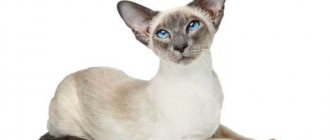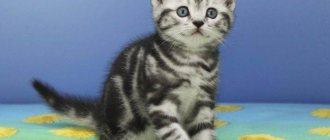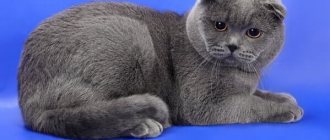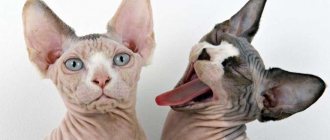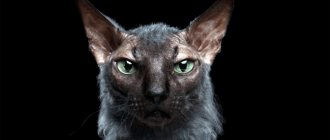It's no secret that cats have good vision, especially in the dark. But, alas, tragedies happen in the lives of some pets - they go blind. There may be several reasons:
- abnormal intrauterine development of the kitten or birth trauma;
- mechanical damage;
- age-related changes;
- complications after advanced eye infections.
The latter serves as another reminder that in case of any inflammatory process that affects the cat’s visual organs, it should definitely be shown to a veterinarian. Indeed, in some cases, vision can be restored or its complete loss can be prevented.
However, if this has already happened, if you decide to adopt a kitten that is blind from birth, or if blindness gradually occurs due to the animal’s advanced age, do not despair. The main task of the owner in this case is to provide his pet with complete comfort.
Instead of vision, the animal's main sources of information will be smell, hearing and touch. Therefore, it is necessary to focus on them.
Belova
Editor of the section “Dermatology”
Practicing veterinarian, lecturer in veterinary dermatology and allergology at the Estonian Agricultural University, diploma holder of the European College of Veterinary Dermatology
In 1995 she graduated with honors from the Estonian Academy of Agriculture with a degree in veterinary medicine. From the moment of graduation to this day, he has been a practicing veterinarian, specializing in dermatology for the last 12 years. The main patients are dogs and cats, less often horses and other animals. Trained in the best dermatological clinics under the guidance of leading specialists, for example:
- 2000–2001, dermatological clinic of Dr. D. Carlotti in Bordeaux, France.
- 2004, Dermatology Department, Pet Clinic, The Royal (Dick) School of Veterinary Studies in Edinburgh, Scotland.
- 2005, Dermatological Department of Veterinary Clinic, University of California (Davis), USA.
- 2006, 2008, Department of Dermatology, Small Animal Clinic, University of Munich. Ludwig Maximilian, Germany.
- 2007, Department of Pathology, Veterinary Faculty, University of Bern, Switzerland.
- 2010, Department of Dermatology at the Small Animal Clinic and Equine Clinic of the Veterinary Institute in Uppsala, Sweden.
- 2011, Department of Dermatology, Small Animal Veterinary Clinic, University of North Carolina (Raleigh), USA.
Since 1999, he annually takes part in international veterinary congresses, seminars and master classes. Since 2005, he has been lecturing on dermatology at the Estonian Agricultural University, teaching senior students in clinical dermatology. From 2007 to 2011 she completed a residency program at the European College of Veterinary Dermatology at the University of Zurich. Member of the European Society of Veterinary Dermatologists, member of the International Society of Veterinary Dermatopathologists, member of the Estonian Small Animal Veterinary Association. Actively participates in postgraduate education, receiving trainees from Russia and the Baltic states at the clinic, participating in conferences and master classes organized in Estonia, Latvia, Lithuania, Russia, Ukraine, Belarus, Poland, Hungary. She gave her first lectures on dermatology in 2002 in Latvia. To date, she has prepared and delivered more than 60 lectures and master classes on dermatology in Russian, English and Estonian.
In 2010, she won the Golden Scalpel award in the Lecturer of the Year category. The Estonian Veterinary Association awarded the title "Best Veterinarian 2010".
Professional interests: patients with atopic dermatitis, histopathology, clinical photography.
Happily married, has a daughter, Christina. And of course, there were pets - the family has two beagles, two cats, a horse and a hamster.
Hobbies: traveling, horse riding.
How to care for a sick pet: features
Blind cats that live in an apartment or house often adapt to this situation. It is important for the owner to follow certain rules and, of course, love his pet. First of all, you should give up free range. If your cat likes to walk outside, this can only be done with a leash. It is recommended not to make drastic changes in the apartment, so as not to disorient the cat. Young blind cats love active play, so it is recommended to use toys that make sound signals. Otherwise, you need to care for such animals in the same way as healthy relatives. Don't forget to visit your doctor periodically.
The cat went blind: prevention and precautions
Eye problems in cats can be avoided if you follow some rules.
- Do not let your pet interact with sick or stray animals.
- Provide him with proper nutrition, balanced in vitamins and microelements.
- Ask your veterinary ophthalmologist to recommend preventative eye drops for your cat. Washing your eyes is a good way to prevent diseases.
- Learn to provide first aid. If your cat is injured, rinse the eye with Ciprovet veterinary eye drops. If an eye falls out, immediately take the animal to an ophthalmologist, dripping a solution of “natural tears” or at least saline every few minutes so that the cornea does not dry out.
How does the sense of smell compensate for the lack of vision?
Another analyzer that plays an important role as a compensator for lack of vision is the sense of smell. With its help, the cat will navigate where the food is and where its tray is. Therefore, the first few times you will need to take the kitten to the tray yourself and not immediately remove it. The smell will allow the baby to navigate where to go next time.
As for old cats that were trained to use the toilet while they were still sighted, they rarely have problems finding it. After all, they have walked a familiar route many times, and are able to reach it (or, say, their bowl) without thinking. In this case, it is not recommended to change the location of important objects for the cat: toilet, water container, food bowl, favorite resting place (house, chair, etc.)
Causes of vision loss
In animals, vision loss can be sudden, for example, due to trauma, mechanical damage to the eyeball, stroke, or brain damage. Blindness can also develop gradually due to inflammatory processes in the optical system of the eye (ocular neuritis, development of diabetic cataracts, degenerative processes in the retina).
Veterinarians distinguish between congenital and acquired blindness in cats. Congenital anomalies account for 5 - 10% of all cases of treatment with the disease. The main share of visual pathology is acquired blindness due to injuries, eye diseases, and systemic diseases of internal organs.
Ophthalmological veterinary practice shows that among the many reasons leading to loss of vision in a domestic cat, the most common are:
- Accompanying illnesses.
in domestic cats is accompanied by the development of destructive processes and often leads to complete blindness. Pathogenic microorganisms - chlamydia - can cause a shutdown of visual function.
In rare cases, the cause of visual impairment is dietary errors caused by vitamin deficiencies
. Old and weakened pets are susceptible to the disease. Blindness in old age is a common occurrence among felines.
What are hallucinations, what are they?
Hallucinations are images that appear in a person’s consciousness. Most often these are symptoms of a psychological illness. A person may also experience auditory hallucinations. Healthy people can also experience hallucinations, but as a result of severe overwork of the body. If this condition is not uncommon for you, then you should think about treatment.
Free consultation right now!
Online consultation with a specialist on your issue!
License number: LO-77-01-019036
What to do to restore the animal's ability to see?
Drug treatment of pathology depends on the causes of its occurrence, in some cases they resort to surgery.
The treatment regimen depends entirely on the established diagnosis. If the cause of blindness is inflammatory processes in the body, a course of antibiotics and anti-inflammatory drugs is prescribed. For glaucoma, therapy is aimed at reducing ICP; normalizing blood pressure will be necessary if hypertension is the root cause of the pathology. For cataracts at the initial stage of development, the doctor prescribes special ophthalmic drops; if the disease is advanced, you will have to undergo surgery to replace the lens.
Return to contents
What to do if you have hallucinations?
Today, there are a huge number of methods for treating hallucinations, and different methods are aimed at eliminating different types of hallucinations. It must be said that therapy is often aimed at treating the cause of hallucinations. But, unfortunately, it is not always possible to eliminate the cause of the disease. It is necessary that hallucinations or the disease that caused them be diagnosed by an experienced specialist. Do not be shy or wait for an exacerbation; you should consult a doctor immediately.
Get a consultation at the psychiatric department of the KORSAKOV clinic.
How to identify hallucinations?
Diagnostics involves determining whether there is a difference from the illusory deception that a healthy person may have. It is necessary to look at the general condition and behavior of the patient, check whether he has delusions or other mental illnesses. Analyze his facial expressions, gestures, check whether he has a feeling of anxiety, and based on the overall picture, draw a conclusion about the person’s condition. This way you can understand whether a disease exists, and if so, determine the degree.
How to deal with hallucinations?
The first step is to diagnose the cause of the hallucination and possible diseases. Next, you need to prescribe a course of appropriate treatment.
At the diagnostic stage, an anamnesis is collected, it is clarified what exactly the patient sees, hears and feels. A thorough examination of what is visible, audible, and felt is carried out, an examination is carried out and a method of treatment is selected. The method of monitoring and caring for the patient is also selected.
Online consultation with a specialist
regarding your question!
License number: LO-77-01-019036
How to determine pathology?
An unsteady gait and cautious, slow movements may indicate the animal is blind.
If an old or young cat for some reason has ceased to see normally, you can understand that something is wrong with the animal by the following symptoms:
- Careful, slow movements in a familiar room.
- In an unfamiliar place, the animal tries not to move, looks closely for a long time, and bumps into objects.
- The cat refuses to jump or climb to heights.
- The gait becomes unsteady.
- The gaze is cloudy, the pupils are large, and do not respond to light stimuli.
- The cat becomes shy, fearful, and nervous.
Return to contents
Diagnostics
If the owner, based on characteristic symptoms, notices that not everything is in order with the visual function of his four-legged friend, it is necessary to find out an accurate diagnosis as soon as possible and begin treatment. Therefore, you should first visit a veterinarian who will conduct an initial examination and then give a referral for a comprehensive diagnosis. The following methods will help check the condition of the visual system:
- ophthalmoscopy;
- electroretinography;
- Ultrasound of the eyeball;
- MRI of the brain;
- blood pressure measurement.
Is there a chance for a newborn blind kitten?
Faced with an animal's blindness at a young age, the owner wonders how
a kitten will exist without such a vital sense organ.
Having gone blind early, the kitten will perfectly navigate familiar surroundings using other senses.
Of course, there can be no talk of any free walking on the street, where the animal faces many dangers. A disabled cat should only be taken for a walk on a harness under close supervision. It is also advisable not to rearrange the furniture in the room, so as not to disorient the animal.
From pets that become blind at an early age, companion cats grow up, following their owner always and everywhere. Having good hearing, blind animals actively respond to the owner's voice. A disabled cat will be happy to take part in active games. For this purpose, it is necessary to use toys with a sound signal.
Blindness in a domestic cat can occur for many reasons. In this case, acquired vision loss is most often diagnosed in veterinary practice. When blindness develops, the first thing that changes is the behavior of the animal.
An ophthalmological examination using modern diagnostic methods will not only reveal the fact of the pathological condition, but also determine the cause and treatment strategy. For domestic cats, blindness is not a death sentence and, with proper care, does not cause problems for the owner.
Types of hallucinations
To understand what to work with, hallucinations must be classified into certain types.
It must also be said that all hallucinations are divided into 2 types.
- True hallucinations - a person perceives false objects in the world around him and believes that they are part of reality.
- False - a distortion of reality occurs in the patient’s head. imply
Hallucinations can be simple or complex. Those. the malfunction may affect one or more sensory organs. And the more organs that are affected by hallucinations, the more difficult the treatment becomes.
Visual hallucinations
As a result, false images of objects, people, living beings, and various objects appear in the human mind, but the patient perceives them as part of reality. In addition, a person sees a certain sequence of actions (as if some plots of a film) and can take an active part in them. This happens after an overdose of alcohol, drugs, or taking serious medications incorrectly. Such visions haunt a person.
Auditory hallucinations
A person hears voices, various sounds, hears his name or being told to do something, but only he hears it; in reality, it does not exist. Auditory hallucinations are detected in acute mental illnesses, such as schizophrenia.
Sometimes they can be caused by an overdose of various substances, similar to visual ones.
Olfactory hallucinations
They are the least common. A person smells non-existent odors. Occurs after brain injury or schizophrenia. They may also appear after the passage of an infectious disease.
Taste hallucinations
The patient experiences sharp and unpleasant sensations in the oral area, resulting in a refusal of any food.
Tactile hallucinations
A person feels the presence of an object (creature) on the body that does not exist; there may also be a sensation of the object moving around the body. In this case, a feeling of sharp heat or cold occurs. The patient experiences unpleasant tactile sensations on the body. Severe pain or scratching.
Hypnagogic hallucinations
They appear when a person (and most often a healthy one) falls asleep. Awareness appears in the form of masks, plant monsters and any other physical objects. Such hallucinations are a harbinger of an imminent mental disorder and a reason to consult a specialist, or call a psychiatrist at home.
Write to WhatsApp
COST OF TREATMENT
The structure of a cat's eyes
There is a generally accepted but unproven belief that four-legged animals see the world in black and white. Experiments conducted to confirm monochromatic vision have not given clear results; it is believed that cats can distinguish shades of blue, green and red. The structure of the “striped” eyeball is very similar to that of humans; before the “picture” reaches the brain, the spectrum of light rays passes through:
- The cornea is the visible surface of the eye, which is covered with mucous membrane.
- The eye chamber is the space bounded by the cornea and iris. The chamber is filled with a transparent liquid, performs a protective function, and allows you to restrain inflammatory processes.
- The pupil is located on the iris. Depending on the brightness of the lighting, the pupils reflexively narrow or dilate (accommodation). The central nervous system is responsible for its correct functioning.
- The lens is the part of the eyeball responsible for refraction and separation of light rays into a spectrum. It has a transparent structure and the shape of a round lens, convex on both sides.
- The vitreous is a thick, jelly-like clear fluid that fills the cavity between the lens and the retina.
- Retina (photosensitive membrane) - consists of receptor cells, rods and cones, which convert the received information into a nerve impulse.
- The optic nerve is a pair of nerve endings that transmit the converted impulse from the retina to the brain.

